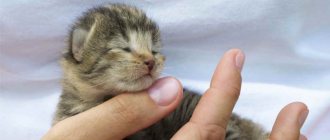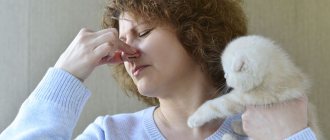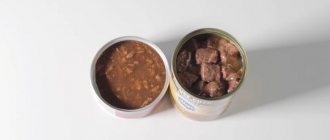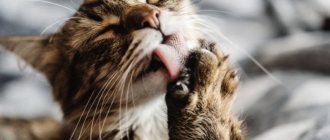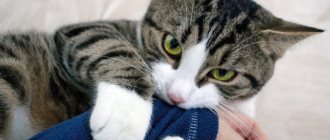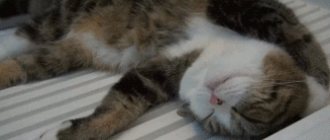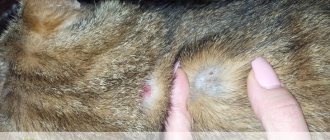Ear flattening as a way to express emotions
Before you worry about the health of a cat that presses its ears to its head, you need to track the situation in which it does this. Perhaps this behavior is just a way of communicating and showing certain emotions. In a number of situations, pets demonstrate their mental and physical state in a similar way:
- Stroking . A cat always presses its ears to its head when being petted - it does this to show maximum pleasure and demonstrate its desire to receive more affection.
- Manifestation of the hunting instinct . Seeing a fly or mosquito, the cat begins to hunt for it. At first, her ears are raised high as a sign of maximum concentration and attention to the object. When approaching a target, the ears will be pressed to the head.
- Protection . When a pet caresses its owner's leg or scratches its head on an object, it will press its ears to its head so as not to touch them.
- Manifestation of fear . In this situation, not only will the ears change their direction, but the cat’s entire posture will be as compact as possible.
- During sleep . By pressing its ears to its head, the cat retains maximum heat inside the body. Pets do this mainly during cold weather.
- Fright . A sharp, irritating sound suddenly heard by a cat will initially frighten it, causing its ears to immediately drop to its head. Only after a second, having calmed down, she will raise her ears, looking for the source of irritation.
- Display of sexual behavior. Unsterilized animals often flatten their ears due to sexual heat, indicating their readiness to reproduce.
You should be wary of a situation when a cat changes the direction of its ears for no apparent reason, and also shakes its head.
Such a symptom may indicate the presence of certain diseases and pathological conditions in the animal.
My cat's ears itch - is this normal?
It is normal for a living creature to scratch its ears. This way the pet cleans them of dirt and foreign particles. He can do this up to several times a day and it will be within normal limits. When does ear scratching cease to be a daily hygiene procedure? It is worth noting that:
- The animal is worried when scratching, the cat shakes its head irritably and actively.
- The pet became nervous and irritable.
- When brushing, the cat purrs or hisses.
- Scratching became more frequent up to 10 times a day.
- Bleeding wounds appeared in or behind the ears.
If several of the listed signs coincide, you should think about visiting a veterinarian.
Pathologies and diseases
Pathological causes of ears pressing to the head:
- Itching of the skin . In this case, pressing the ears is a reaction to ear or subcutaneous mites or fleas. If there is a subcutaneous tick, your pet's ears will often be pinned back. The itching will spread to the face, neck, and entire body.
- Jumps in blood or atmospheric pressure . They usually manifest themselves as a sudden headache.
- Neurological disorders that can cause auditory hallucinations in an animal.
- Painful sensations. Various diseases can provoke attacks of pain. As a rule, the cat also has other accompanying symptoms: it refuses food, stops being active, preferring to lie down most of the time, and changes its behavior.
If the cat has become lethargic, refuses to eat, does not go into the owner’s arms, shakes its head or constantly itches and at the same time presses its ears to its head, this is a reason to contact a veterinarian as soon as possible.
My cat's ears itch - is this normal?
It is normal for a living creature to scratch its ears. This way the pet cleans them of dirt and foreign particles. He can do this up to several times a day and it will be within normal limits. When does ear scratching cease to be a daily hygiene procedure? It is worth noting that:
- The animal is worried when scratching, the cat shakes its head irritably and actively.
- The pet became nervous and irritable.
- When brushing, the cat purrs or hisses.
- Scratching became more frequent up to 10 times a day.
- Bleeding wounds appeared in or behind the ears.
If several of the listed signs coincide, you should think about visiting a veterinarian.
Appearance Features
Among the characteristics of the breed are:
- a muscular, lean body of medium size with a powerful chest and fairly strong limbs;
- wedge-shaped head;
- oval large eyes of green, blue or golden color;
- silky fine coat and small undercoat.
These animals can become true friends, but their big drawback is that their ears require very careful care. Cats are curious and get along with children.
Ukrainian Levkoy
The Ukrainian Levkoy is an original looking hairless fold cat. The Levkoys contain the blood of Donchak and Orientals (via Peterbalds), and to obtain lop-eared blood, the blood of Scottish Folds was once infused, but indirectly, that is, through a mestizo.
With a slender build, graceful long neck, expressive coordination and folded back ears, these are elves. If we omit the breeding branches and simply say, then Elves are a mixture of curl and sphinx.
Inner ear
In cats, the inner ear (labyrinth) is the deepest part of the entire auditory system. It includes the sensory structures of the apparatus and balance. The ear canal is protected here by the temporal bone. In this ear of cats there is a very important organ of Corti, which converts sounds coming from the eardrum into electrical impulses that are transmitted through neural networks to the brain.
In addition, the vestibular apparatus is located in this area - three semicircular small fluid-filled canals. They contain microscopic hairs. All fluid movements are captured by these bristles, which generate nerve impulses. The brain receives these signals and determines the horizon line, the position of the body, where is up and down and the animal maintains balance.
Thus, in cats, the ears consist of a sound-receiving system and organs that help animals maintain balance during movements.
Owners of such delicate pets should know the structural features of cats' ears in order to properly care for these important organs.
Outer ear
This part includes:
- Auricle. In most breeds it is erect and straight. But there are animals with hanging, curved ears.
- Auditory canal.
The cartilage of the outer ear is slightly concave, on the outside it is completely covered with hair, on the inside it has delicate skin and long thin hairs.
Ear canal with pink thin tissue. This part contains the sulfur glands. The color of sulfur in cats is not yellow, like in humans, but brown. In healthy animals, these accumulations are practically absent in the canal.
At the end of the ear canal there is a membrane. It is not visible from the outside. It is well protected by the large bend of the channel, thus being practically “around the corner”. Thanks to this, the most important organ is reliably covered and protected from injury.
Ear infection
Why does a cat shake his head from side to side and scratch his ears? It is possible that he has inflammation of the inner, outer or middle ear. This disease may appear due to untreated or severe scabies. Other causes of inflammation:
- sulfur plug;
- hypothermia;
- foreign object in the ear.
Sometimes this disease is provoked by infections. If there is pancreatic or liver dysfunction, the cat may also scratch its ears. Brown pellets are also observed in the shells.
Symptoms of the disease:
- Itching in the ears.
- Uncontrolled head movements.
- Decreased appetite.
- Fluid in the ears.
Breed Features
The Scots are different:
- In good health, with proper care, they can live up to 15 years or even more.
- A stable psyche.
- The animals are quite quiet, meowing very rarely.
- Due to their unusual shape, a cat’s ears (we discussed the structure in the article) are so small that they are almost invisible.
The first representatives of this breed were discovered in Scotland. The ancestors were simple domestic cats, and the folded ears appeared as a result of mutation. After birth, kittens have erect shells that are very small, but as the animal grows up, they acquire their own characteristic feature. Not all babies of this breed become lop-eared. During the first weeks, even an experienced breeder will not be able to predict their future appearance.
American Curl
A wonderful breed of cats with small ears. The animals are very peaceful, have thick fur, which can be either short or long. The pets are active and love to play, they respond well to training, and can walk on a leash with their owner. They are distinguished by small ears with tassels, which makes cats recognizable.
The nature of the animals is flexible, they get along well with children, are unobtrusive, but enjoy playing with their owner. There is another interesting feature in the structure of a cat's ear. A photo of the animal shows how representatives of this breed have ears that curve outward, making the pets look unusual and even funny.
Choosing the right kitten
The most characteristic feature of the American Curl is the curl on the ears. This is exactly why you need to choose a kitten. The best time for this is when the curl is visible clearly and clearly - and this is 4 months from birth. It is after this time that the wrapping of the ears ends.
It will be immediately noticeable whether he will be a breeding cat, whether your pet is applying for an exhibition or will be a domestic cat:• a domestic cat will have the smallest angle of wrapping (the first degree);• a larger angle or another degree will show you a breeding cat, it is better to keep this one for breeding;• steep a curl or third degree is a manifestation of an exhibition handsome man.
The price of the kitten will depend on this. Ideally, a kitten's ear curl should be in the form of a neat curve, similar to a crescent. It is worth noting that in advance, before the end of the 4-month period, it is almost impossible to determine to what degree the ear will twist. You don’t even have to take the kitten’s relatives; two show kittens can give birth to both a show kitten and a domestic one.
READ Diarrhea after vaccination. Diarrhea in a puppy after vaccination: reasons, what to do
In addition to appearance, you need to pay attention to the pedigree of the little Curl. The price will also depend on who its parents were:• if the kitten does not have a pedigree, then its price will be in the range of 3-10 thousand rubles;• pedigree Curls are valued more - from 10 to 20 thousand;• purebred show kittens will cost to the buyer 25,000 or more.
When purchasing, you should read in detail all the documents for the kitten, and especially look at its behavior. They should be calm and not at all shy.
Scottish straight
The straight-eared representatives of the Scottish breed were not recognized by the felinological society for a very long time, classifying them as a British breed. It was only in 2004 that the standards were revised, as the straight-eared Scots began to differ markedly from their British ancestors. This is how straight-eared Scots got the name “Scottish Straight”.
The difference between folds and straights is only in the shape of the cat's ears. “Straight” means “straight” and we are talking specifically about the cat’s ears. Scottish Straight ears are larger than Fold ears, straight, but with the same rounded tips. Otherwise, straights and folds are no different from each other.
Kankalow
This breed was developed almost by accident - Terry Harris from America decided to “create” cats with tiny, short legs. Thus, Curls were crossed with Munchkins. The Kinkalow breed was first registered in 1997 and a standard was recognized. The cat has a strong build, a long tail and ears that are curved slightly back. Short legs are a distinctive feature of these cats.
Therapy methods
Treatment depends on what problem is causing the itching. This could be dermatitis, fungus, ear mites, otitis media and other pathologies.
Dermatitis should be treated with drops containing novocaine. Using a swab dipped in hydrogen peroxide, the crusts are carefully removed, and the ulcers are treated with an astringent ointment.
Fungal infections are treated with antifungal agents.
Ear mites are removed by mechanical cleaning of the ear canals. A swab soaked in hydrogen peroxide is used. Additionally, medicinal drops and ointments are used. In case of advanced disease, injections with antibiotics are prescribed.
Therapy for otitis media is selected depending on the disease. First of all, you need to treat the ears with a cotton swab with peroxide.
Immediately after these manipulations, treatment procedures using the following drugs begin:
- Leopard;
- Otoferonol premium gold;
- Aurikan;
- Oricin;
- Surolan;
- Ordermil.
Tick-borne otitis media is treated comprehensively. Drugs prescribed:
- Anandin;
- Tsipam;
- Decor.
Antimycotic agents are also used:
- Clotrimazole ointment;
- shampoos Nizoral, Sebazol.
The products are applied to the inside of the ear. They cannot be washed off, otherwise there will be no therapeutic effect.
For fungal and yeast forms of otitis, it is necessary to strengthen the animal’s immunity.
The bacterial variety of pathology often leads to the development of diseases that are difficult to treat.
Local medications are prescribed:
- Otonazole;
- Otibiovin;
- Mastitis.
Advanced forms of the disease are treated with novocaine blockades with antibiotics. After the course of treatment, preventive treatment is carried out. This helps prevent relapses.
Special drops are used against fleas; they are applied to the withers. If the animal is often outdoors, then an anti-flea collar is used.
Detected hematomas, formations, and polyps are removed surgically. Identified foreign bodies are removed immediately. The animal's ears are treated with antiseptic drugs.
Features of treatment
The therapeutic course is selected by the veterinarian and depends on the diagnostic results. For otitis media, antibacterial treatment is prescribed. If the pain syndrome is severe, a novocaine blockade is done, and special drops for otitis media are instilled into the ear.
You can get rid of ticks using external means such as Tactic, Amit. Intramuscular injections of antiparasitic drugs are effective. The ears are first cleaned of exudate with a cotton swab dipped in hydrogen peroxide. For dermatitis, the auricle is treated with a solution of silver nitrate.
During treatment, you must be observed by a doctor, visiting the clinic at least once a week.
